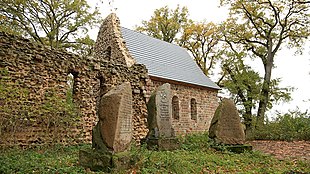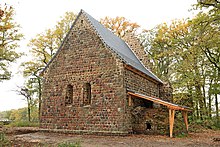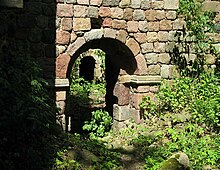Dambeck church ruins
The Dambeck church ruins are located north of the village of Dambeck in the municipality of Bütow in the Mecklenburg Lake District in Mecklenburg-Western Pomerania .
history
The church is one of the oldest stone churches in southern Mecklenburg. It was probably built around 1180 as a late Romanesque fortified church. Dambeck was first mentioned in a document in 1261. The place was originally close to today's church ruins on Dambecker See (Bütow) and belonged to the diocese of Havelberg and the archdeaconate of the new town of Röbel .
From the 15th century, the von Freibergs , who also owned Gut Karchow , settled in Dambeck. During the Thirty Years' War the von der Lühe took over Dambeck until 1743. Dambeck and Karchow then went to Friedrich von Bassewitz on Klocksin until 1791 . Afterwards the chamber councilor Otto Konrad von Hahn had both goods for a year until they passed to Ludwig Christoph Baron von Langermann-Erlenkamp and his family.
Since 1528 Joachim Berg was under the patronage of the state and that of Freiberg Kirchherr von Dambeck, Karchow, Bütow and Minzow.
In 1649 the thatched roof of the nave collapsed. By 1662 the roof had been repaired and the connection between the choir and the nave walled up. Only the choir was usable; the rest of the church was desolate.
Around 1800 the Dambeck village and manor were relocated a few hundred meters south to their current location. All that remained of the old place was the partly desolate church, which was used for devotions until 1920 by the communities of Dambeck and Minzow (today part of Leizen ).
Around 1900 there was still an altarpiece from the Renaissance and a painted pulpit. In 1954 a fire destroyed the church roof and the rest of the inventory. During a thunderstorm with lightning in 1954, the ammunition hidden here from World War II exploded. Since then, the church ruins have been left to decay. The cemetery was looked after by members of the LPG Dambeck for a few years .
A historic bell from 1704 was placed in the Minzow village church .
In order to stop the further deterioration of the culturally and historically valuable church ruins, eight members founded the Friends of the Dambek Church Ruins in May 2014 with a clear concept . e. V. The restoration, which was completed in 2019, was an exemplary success.
description
The church consisted of the nave , the choir and a sacristy that was probably added later . All the walls of the church are made of neatly machined cuboid field stones that have been connected with lime mortar . Inside, the walls were filled with raw field stones in lime mortar. The pavement, the (former) vault above the chancel and that above the sacristy were made exclusively from field stones. No brick was used for the entire church as there were no brick kilns in the area in the 12th century. At some flaws in the external field stone facing you can still see the layered structure of a field stone wall.
Around the church in the former churchyard there are some more recent graves, including that of Freiherr Friedrich von Langermann and Erlencamp (1854–1935).
swell
Printed sources
- Mecklenburg record book (MUB)
- Mecklenburg Yearbooks (MJB)
literature
- Friedrich Schlie : The art and history monuments of the Grand Duchy of Mecklenburg-Schwerin. V. Band. The district court districts of Teterow, Malchin, Stavenhagen, Penzlin, Waren, Malchow and Röbel. Schwerin 1902, reprint 1993, ISBN 3-910179-09-6 A. 527-534.
- Georg Dehio : Handbook of the German art monuments, Mecklenburg-Western Pomerania. Munich, Berlin 2000, ISBN 3-422-03081-6 , p. 103.
- Heidrun Scherfig-Drese: Dambeck church ruins. History - concept - goals. Minzow 2015.
Web links
Individual evidence
- ↑ MUB II. (1864) No. 911, MUB IV. (1867) No. 2486.
- ^ Friedrich Schlie: Das Gut und Kirchdorf Dambeck. 1902. p. 527.
- ^ Friedrich Schlie: Das Gut und Kirchdorf Dambeck. 1902, p. 528.
- ^ Heidrun Scherfig-Drese: Dambeck church ruins. History - concept - goals. 2015, p. 13.
Coordinates: 53 ° 22 ′ 7.7 ″ N , 12 ° 29 ′ 59.1 ″ E


